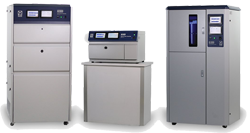耐候性試驗
Weathering Testing
咨詢熱線
18566398802ASTM G156-2017
ASTM G156-2017標準介紹
ASTM G156 用作監控曝曬測試環境的持續性的老化參考材料的選擇和鑒別的標準方法(風化標準物質的選擇與表征的標準實施規程)
ASTM G156-2017發行信息
中文名 風化標準物質的選擇與表征的標準實施規程
英文名Standard Practice for Selecting and Characterizing Weathering Reference Materials
標準號ASTM G156-2017
發布日期2017
實施日期
廢止日期無
中國標準分類號A21
國際標準分類號19.040
發布單位US-ASTM
ASTM G156-2017適用范圍
Weathering reference materials are used in laboratory accelerated exposure tests to verify consistency among tests run at different times and in different laboratories, using the same exposure conditions. Specifications defining consistency of exposure conditions are based on the property change of a reference material after a defined period of time. Some weathering reference materials are used to define periods of exposure. Specifications calling for use of these materials require the material to be exposed until a defined change in the weathering reference material is achieved. Specifications are usually based on results for a single lot of the weathering reference material. When a new lot of the reference material is introduced, round-robin studies are necessary to compare the new and old lots and to establish appropriate limits for expected performance of the new lot.
Note 28212;An example of the use of a clear polystyrene reference standard for this purpose is given in SAE J1885 and SAE J1960.
Note 38212;Some weathering reference materials (for example blue wools) are also used to define periods of exposure. Although not specifically covered by this standard, the procedures described for characterizing a reference material used to monitor consistency of exposures are also generally applicable to characterizing reference materials used to define periods of exposure.
It is important to test the consistency of exposure in the laboratory accelerated device with a weathering reference material that responds to the test conditions similar to the way the test materials respond. Therefore, the weathering reference material should be sensitive to the spectral region of the light source mainly responsible for producing degradation in the test materials to provide the most meaningful evaluation of exposure test consistency. The weathering reference material should also provide information on consistency of temperature and humidity conditions if the latter are important factors in degradation of the test materials.
Note 48212;Material homogeneity can also be an important factor in selection of a weathering reference material, particularly if weathering is initiated by the radiation absorbed by impurities as is the case in aliphatic type polymers exposed to radiation longer than 300 nm.
The measurement of the characteristic property of a weathering reference material can be subject to error depending on the instrument and the procedure used to measure the property. It is important to develop measurement procedures that are clear and which minimize chances for operator misinterpretation. It is also important to determine the level of variability caused by measurement of the characteristic property.
When a reference material is used to monitor or specify the consistency of an exposure test, it is important that any specification limits defined by changes in the reference material be based on a sound statistical analysis of results from a properly designed round-robin experiment. This practice provides a procedure which can be followed to set up the round-robin, analyze results, and establish reasonable limits of change in the characteristic property of the reference material that can be used in specifications.
The results obtained according to this practice are valid only for the exposure cycle used for the round-robin and cannot be applied to the same weathering reference material used in a different exposure cycle.
The change in characteristic property of a reference material may be affected by the placement of the reference material in the exposure device. This is often due to variations in light intensity and temperature within the allowed exposure area. Random placement of replicate specim.........
1.1 This standard describes the criteria to be used for selection of a weathering reference material (WRM) and procedures to be used for determining within lab and between lab tolerances of changes in measured properties of weathering reference materials. This standard also describes a procedure for comparing different lots of the same type of a weathering reference material.
NOTE 1:Examples of laboratory accelerated tests in which a weathering reference material could be used to monitor consistency are exposure tests such as those described in Practices G152, G153, G154, and G155and other standards in which tests conducted according to these standards are referenced. Examples of outdoor exposures where a weathering reference material could be used to monitor consistency are those conducted according to Practices G7, G24, or G90. A reference material can also be used to monitor consistency of exposure or conditioning test that do not involve exposure to light.
1.2 Weathering reference materials are most often used to (1) monitor consistency (that is, repeatability, reproducibility, or both) of exposure tests, (2) to determine the time or radiant exposure at which test materials are evaluated, (3) as a reference material for comparing to test materials exposed at the same time. Weathering reference materials cannot be used to classify or characterize the relative severity of any exposure test because of the large variability in material responses to the effects of light, heat, and water.
1.3 This practice does not cover control materials which, by definition are selected to be of similar composition and construction to the test materials, and are exposed at the same time as test materials.
1.4 This practice provides an outline of experiments required to determine how the measured properties of the reference material change as a function of exposure to specified test conditions. It includes establishment of reproducible measurement procedures, determination of the critical spectral region in the light source causing the changes, and effects of other critical exposure stresses such as temperature and moisture.
1.1本標準描述了用于選擇風化標準物質(WRM)的標準以及用于確定實驗室內和實驗室間風化標準物質測量特性變化公差的程序。本標準還描述了比較同一類型風化標準物質不同批次的程序。
注1:可使用風化標準物質監測一致性的實驗室加速試驗示例包括暴露試驗,如規程G152、G153、G154和G155中所述的試驗,以及根據這些標準進行試驗的其他標準。可使用風化標準物質監測一致性的室外暴露示例是根據規程G7、G24或G90進行的暴露。參考材料也可用于監測不涉及光照的暴露或調節試驗的一致性。
1.2風化標準物質最常用于(1)監測暴露試驗的一致性(即重復性、再現性或兩者兼有),(2)確定評估試驗材料的時間或輻射暴露,(3)作為與同時暴露的試驗材料進行比較的標準物質。由于材料對光、熱和水影響的響應具有很大的可變性,因此不能使用風化參考材料對任何暴露試驗的相對嚴重性進行分類或表征。
1.3本規程不包括控制材料,根據定義,控制材料的成分和結構與試驗材料相似,并與試驗材料同時暴露。
1.4本規程提供了確定標準物質的測量特性如何隨暴露于規定試驗條件而變化所需的試驗大綱。它包括建立可再現的測量程序,確定引起變化的光源中的臨界光譜區域,以及溫度和濕度等其他臨界暴露應力的影響。
溫馨提醒:本ASTM G156-2017可能存在更新的版本,建議尋找ASTM G156-2017的發行商確認。

 粵公網安備 44060402000067號
粵公網安備 44060402000067號